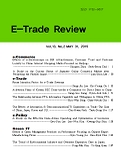The Effects of Information & Telecommunication (IT) Capabilities on Trade: The Case of China, Japan, Korea and the U.S.
The Effects of Information & Telecommunication (IT) Capabilities on Trade: The Case of China, Japan, Korea and the U.S.
- 중앙대학교 한국디지털무역연구소
- 디지털무역리뷰
- 제13권 제2호
-
2015.12117 - 135 (19 pages)
- 8

Purpose: This paper, based on the presumption that a higher level of IT capability reduces transaction cost of trade, examines the effects of IT capability on trade between China, Japan, Korea, and the U.S. Composition: Chapter Ⅰ, as the introduction, presents the background and purpose of this paper. Chapter Ⅱ reviews prior literature, including the analyses of trade with respect to the export-import function. Chapter Ⅲ reports the status of IT capabilities in the four countries, China, Japan, and Korea, and the U.S. Chapter Ⅳ presents the analytical model with explanatory variables and data. The main results of this study are presented in Chapter Ⅴ. Lastly, summary and the concluding remarks follow in chapter Ⅵ. Findings: Using the panel regression model, this study shows that the levels of IT capability do have statistically insignificant impacts on bilateral exports and imports among the four countries, so that IT capability does not have a role on trade structure directly. However, for the individual country, the level of IT capability has a positive effect on Korea’s exports and imports, but a negative effect towards China which has very lower level of IT capability. Originality/Value: Therefore, in order to increase the role of IT capability in the trade structure, it is necessary to remove various kinds of asymmetric information and regulation on trade and establish trade-related standards to ease transaction process beyond the borders
Purpose: This paper, based on the presumption that a higher level of IT capability reduces transaction cost of trade, examines the effects of IT capability on trade between China, Japan, Korea, and the U.S. Composition: Chapter Ⅰ, as the introduction, presents the background and purpose of this paper. Chapter Ⅱ reviews prior literature, including the analyses of trade with respect to the export-import function. Chapter Ⅲ reports the status of IT capabilities in the four countries, China, Japan, and Korea, and the U.S. Chapter Ⅳ presents the analytical model with explanatory variables and data. The main results of this study are presented in Chapter Ⅴ. Lastly, summary and the concluding remarks follow in chapter Ⅵ. Findings: Using the panel regression model, this study shows that the levels of IT capability do have statistically insignificant impacts on bilateral exports and imports among the four countries, so that IT capability does not have a role on trade structure directly. However, for the individual country, the level of IT capability has a positive effect on Korea’s exports and imports, but a negative effect towards China which has very lower level of IT capability. Originality/Value: Therefore, in order to increase the role of IT capability in the trade structure, it is necessary to remove various kinds of asymmetric information and regulation on trade and establish trade-related standards to ease transaction process beyond the borders
Ⅰ. 서 론
Ⅱ. 이론적 배경
Ⅲ. 연구 설계
Ⅳ. 실증 분석
Ⅴ. 결론 및 시사점
참고문헌
(0)
(0)